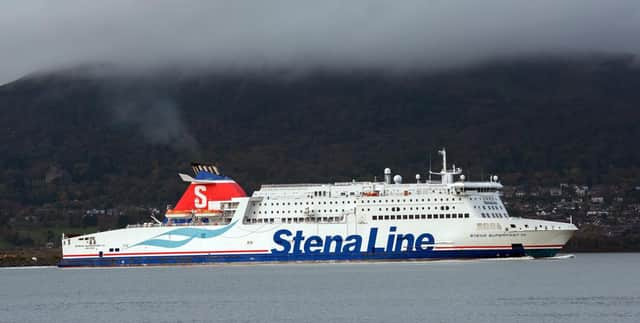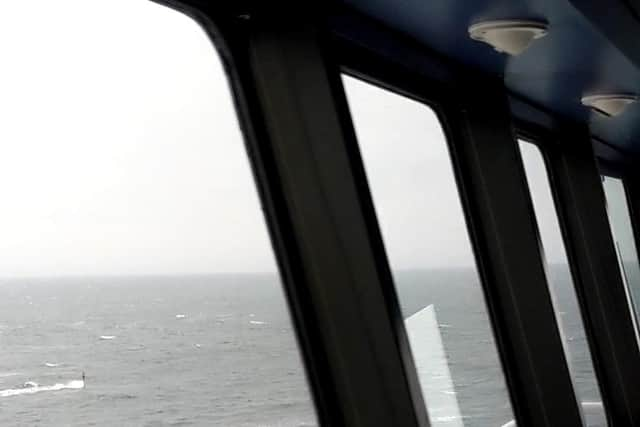Stena ferry crew averted submarine collision disaster by spotting periscope


The two vessels came within 50-100 metres of each other west of the Rhins of Galloway on 6 November, 2018, a Marine Accident Investigation Branch (MAIB) report stated today.
The UK Department for Transport body said: “Although there was no collision, this was the third accident or incident between a dived Royal Navy submarine and a surface vessel in four years, which is a matter of significant concern.”
Advertisement
Hide AdAdvertisement
Hide AdThe MAIB and the Royal Navy both refused to say whether the submarine involved was one of the four nuclear-armed Trident vessels based at Faslane.


The report said crew aboard the Stena Superfast VII ferry, travelling from Belfast to Cairnryan, “took immediate action to avoid collision” after spotting the submarine’s periscope nearby.
Ferry passengers and the crew on both vessels were placed “in immediate danger” the report found.
The Faslane-based submarine was patrolling an area south of the ferry route when it came close to the Stena vessel, which had 215 passengers and 67 crew on board.
The report said: “This incident happened because the submarine’s control room team overestimated the ferry’s range and underestimated its speed.
“This combination meant the submarine’s commanding officer and its officer of the watch made safety-critical decisions that might have appeared rational to them at the time but were actually based on inaccurate information.”
The report found when the submarine’s control room team initially detected Stena Superfast VII visually, they estimated it to be at a range of 9,000-10,000 yards.
At a speed of 21 knots, Stena Superfast VII would cover 6,000 yards in 8 minutes and 34 seconds, which was an estimate of the time available for the submarine’s officer of the watch (OOW) to take avoiding action.
Advertisement
Hide AdAdvertisement
Hide AdHowever, the report found the OOW had estimated the ferry’s speed as 15 knots, so would have “incorrectly calculated” it would take the ferry 12 minutes to travel 6,000 yards and “almost certainly assessed there was significantly more time to take avoiding action than was actually the case”.
‘Immediate danger’
Following the incident, the master of the ferry notified the coastguard, saying the submarine’s periscope had passed down the starboard side of the vessel at a range of 50-100 metres.
The report said: “During safety training in the North Channel, the command team of a submerged submarine did not take sufficient action to prevent the ferry, Stena Superfast VII, passing inside its go-deep range. This was an unsafe event and placed the ferry’s passengers and crew, as well as the submarine and its crew, in immediate danger.”
It said the ferry’s OOW showed “great presence of mind and strong conviction” in altering course to port to avoid a collision, and warned that “without this alteration, there was a serious risk of collision”.
Andrew Moll, chief inspector at the MAIB, said: “I have today recommended the Royal Navy undertakes an independent review of the actions that have been taken in order to ensure that the risk of similar collisions has been reduced to as low as possible.”
‘Cavalier attitude’
SNP defence spokesperson Stewart McDonald said: ‘This had the potential to be a serious maritime disaster and the Ministry of Defence (MoD) needs to come clean on all the details about who and what was involved, not least if included nuclear-armed submarines.
‘Scotland’s maritime environment cannot continue to be treated with the cavalier attitude that the MoD has become known for.
"We’ve had too many near misses in the past and it’s time ministers took this seriously.
Advertisement
Hide AdAdvertisement
Hide Ad‘It’s vital a government minister gives a statement to Parliament and makes themselves available to answer questions from MPs at the earliest possible opportunity.
"The public has a right to know the MoD takes safety as seriously as it ought to and any lessons required to be learned have been fully acted upon.‘
South Scotland SNP MSP Emma Harper, who has raised concerns about the incident, said: “It is heartening that the report identifies a number of key actions being taken to avoid similar potential collisions in the future.
“However, it is also concerning that it highlights a number of near misses occurred – rather than the one of which we were previously aware.”
‘No nuclear safety issues’
A Royal Navy spokesman said: “Ensuring safety at sea is a top priority for the Royal Navy, which is why we welcome this report and have already taken action to tighten our training and procedures.”
The spokesman said there were no nuclear safety issues in the incident.He said the Royal Navy accepted fully the recommendations of the report.
He said a thorough safety investigation in 2018 “identified the necessary actions to prevent a re-occurrence and these have now been enacted and explained to MAIB”.
A message from the Editor:
Thank you for reading this story on our website.
While I have your attention, I also have an important request to make of you.
Advertisement
Hide AdAdvertisement
Hide AdThe dramatic events of 2020 are having a major impact on many of our advertisers - and consequently the revenue we receive.
We are now more reliant than ever on you taking out a digital subscription to support our journalism.
Subscribe to scotsman.com and enjoy unlimited access to Scottish news and information online and on our app.
Visit https://www.scotsman.com/subscriptions now to sign up.
By supporting us, we are able to support you in providing trusted, fact-checked content for this website.
Joy Yates
Editorial Director
Comments
Want to join the conversation? Please or to comment on this article.